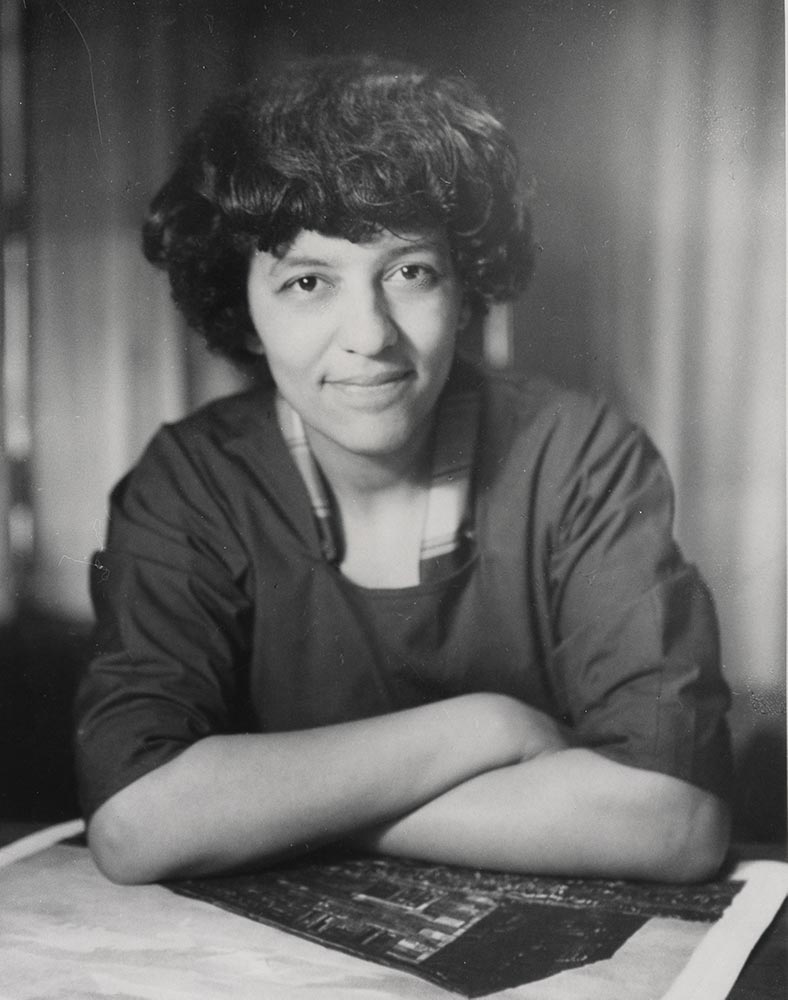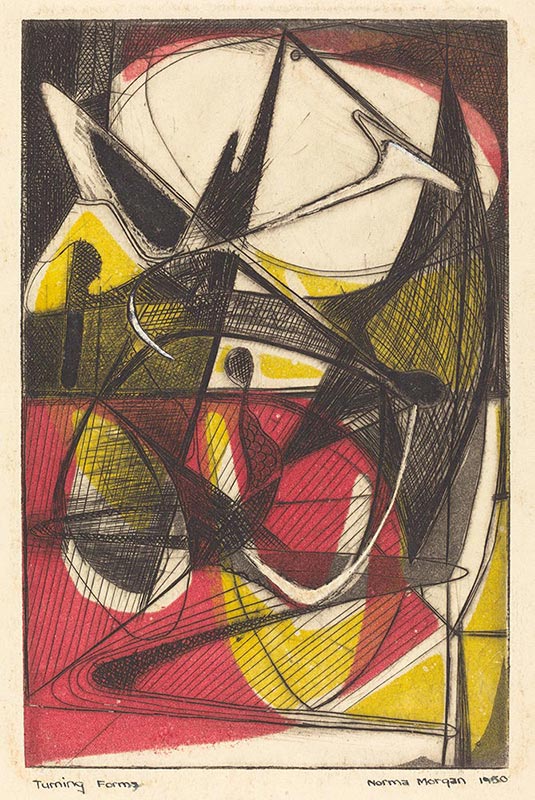61. Norma Morgan
| Life Dates | 1928-2017 |
| Place of Birth | New Haven, CT, USA |
| Place of Death | unknown |
| Birth Name | Norma Gloria Morgan |
Norma Morgan was born in New Haven, Connecticut. After graduating from high school, she attended the Art Students League and also took classes with Hans Hofmann.1 Around 1950 she became a member of Atelier 17 and is one of two known female African Americans, along with Evangeline St. Claire. Her engraving Turning Forms shows the studio’s impact on her style and technique. Dense and deeply engraved lines fill the abstract composition, which is punctuated by areas of scorper relief and highlights from red and yellow stencil. Morgan specialized in the graphic arts throughout her career and had a particular affinity for engraving, which she explained in an interview for the members’ newsletter of the Society of American Graphic Artists (SAGA): “I always painted slowly, so engraving seemed like a solution for me. I engrave from my sketches and my imagination. My work has always been a combination of both sources. You have to be patient to engrave. My fingers got sore.” Morgan participated in Atelier 17’s exhibitions at Grace Borgenicht Gallery (1951) and Peretz Johnnes Gallery (1952). A year after joining Atelier 17, she won a one-year fellowship from the John Hay Whitney Foundation for study abroad in England and Scotland. Prints made during this fellowship period and just afterward represent a major shift in her style. Instead of abstraction, she now concentrated on landscape and representing the moors of the Scottish Highlands. Morgan managed to fill these plates with an enormous variety of textures and tonal variation. In the same SAGA interview, she explained, “Engraving is appropriate for doing rocks, cliffs and trees … I am especially attracted by erosion and objects affected by it.”2 Morgan wanted her art to speak to all audiences, and her focus on landscape and natural subject matter was part of an effort to appeal broadly.3 Morgan exhibited her work extensively, and she received a grant from the Louis Comfort Tiffany Foundation in 1962.4 Eventually, Morgan maintained a studio in New York’s Catskills region, where she continued to practice and care for her elderly mother.5
Selected Bibliography
Conacher, Pamela. “The Highlands in New York City,”, April 21, 2009.
Exler, E. “Norma Morgan: Romanticism and Printmaking.” Sagaletter, Autumn 1990, 5.
Slate, Nico. The Prism of Race: W.E.B. Du Bois, Langston Hughes, Paul Robeson, and the Colored World of Cedric Dover. New York: Palgrave Macmillan, 2014.
Ten Negro Artists Form the United States: First World Festival of Negro Arts. Dakar, Senegal: Distributed by October House, 1966.
Notes
- Information about Morgan’s education taken from Ten Negro Artists from the United States: First World Festival of Negro Arts (Dakar, Senegal: October House, 1966). Despite reference to study at the Art Students League of New York, the school does not have a student registration card for Morgan. ↩
- E. Exler, “Norma Morgan: Romanticism and Printmaking,” Sagaletter (Autumn 1990): 5. ↩
- Nico Slate, The Prism of Race: W. E. B. Du Bois, Langston Hughes, Paul Robeson, and the Colored World of Cedric Dover (New York: Palgrave Macmillan, 2014), 129–30. ↩
- Ten Negro Artists, 1966. ↩
- Pamela Conacher, “The Highlands in New York City,” April 21, 2009, http://northings.com. ↩

